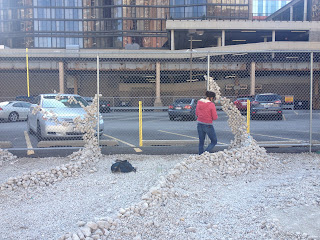A couple of week ago, we had our weekend long class on Material
Social Practices with Fereshteh Toosi, which was very much of an
experiment in itself.
The first evening, Fereshteh gave
us a nice overview of social practice art practices, which are
non-traditional art projects that involving community organizing, public
art, temporary art interventions, more long-term creative placemaking,
and more. One of my favorite examples was the Soil Kitchen group which
seeks to cultivate a better future, not only through installing raised
beds, but working to build up soils, and identify ways to remediate
contaminated urban lands. The subject of social art practices is a fascinating and constantly changing one, that could make for a great semester long history or theory graduate course. One tricky aspect of the course was the short one weekend format, which doesn't quite match the long-term nature of many social arts projects. Fereshteh did a lot to counter this by sending an in-depth questionnaire about the interests and backgrounds of the students, assigning readings for discussion, and creating this class blog developing the conversation over a period weeks.
While I kind of thought our class would have more of an
influence upon the future of the Papermaker's Garden, Columbia's plans
for the space, which are already pretty well set. It was cool to see
that this student initiated garden has sparked real interest amongst the
college administration, with major renovations coming this summer. We
did still brainstorm about other suggestions about this space will
function when more garden beds and a performance space are added.
We were still eager to do what we could to "activate the
space" in the course of the weekend. Most of the rest of the weekend,
our class discussed what changes we could make, given the time,
materials, and skills available. There really is no recipe for
collaborative art making.
In any group, there tends to be people with strong ideas and
others who can build a consensus between individuals with differing
visions. Our group had more consensus builders than folks with strong
opinions about what to be done. So it took awhile to pin down what we
wanted to do as group.
It did feel good to get out into the space and start working
on our rock arranging and ribbon tying, with the properties of the place
and the materials providing further direction on how to proceed. The
evolution of the placement of the rocks from radiating circles to
undulating ridges to the using twine to have the stones begin to ascend
the fence was an example of how the aesthetics developed over the course
of working in the space. The way the ribbons (and their corresponding
shadows) vibrate in the wind, creating an almost psychedelic visual
effect also was a nice surprise.
I feel that we were able to go a long way toward activating
the space in just a few hours of cooperative (and hard work). I am glad
that we have brought more interest in this space. I am still not
convinced that limiting the color palette mainly to blue was the best
choice. I think that large community spaces, especially gardens, are
more interesting with a more diverse array of colors and shapes than the
more restrained use or color and cohesive placement forms that more the
group seemed to favor. Nevertheless, I am always inclined toward
exuberant color and, within groups, it is not so much about the ideas of
individuals as finding a path that everyone can support.
All in all, it was an interesting class. I am very happy to
have gotten to collaborate the fascinating group of artists involved. I
do believe we all came away with more thoughts (and questions) about
social arts practice to take forward.






































